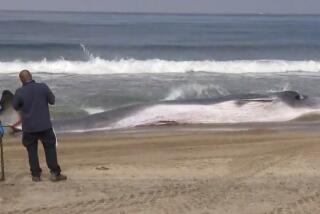Tale of the Whale : Mammals: Volunteers brave the elements to chart the annual migration of the gray cetaceans. The information is vital in determining whether the species is still endangered.
COASTAL — “Blow!”
After shivering for hours in the stiff wind on the 125-foot cliffs of the Palos Verdes Peninsula, eight chilled observers jumped to life with that one word. Binoculars fixed to their eyes, they eagerly peered out toward Santa Catalina Island.
“Where? Where?” they said in unison, leaning eagerly over the stone wall of their Point Vicente observation point. There was a tense silence.
“Wait, I think I see--there! Blow! And flukes from the first!”
Five whales were swimming roughly eight miles offshore, invisible without binoculars, veteran watcher Fran Austin told the growing crowd of passers-by. Exhilarating as it was to watch the pod of creatures spout, show their backs and lift their broad tail fins, called flukes, Austin soon realized that the animals were not what she had planned to see.
Patches of white on their flukes and the shape of their spouts were telltale signs of humpback whales, not the Pacific gray whales she and other American Cetacean Society volunteers were seeking.
So far, the real quarry of the gray whale census takers has been elusive.
Spotters who began duty at the society’s Point Vicente observation post on Dec. 1 saw a single gray whale that first day, lazily swimming southward, a third of a mile off the peninsula as it neared its summer home in the warm lagoons of Baja.
They did not see another gray whale until 10 days later. In the interim, the rotating crew of annual volunteers, which includes everyone from lawyers and pilots to college students and retirees, endured nine-hour days of patient watching in often bone-chilling weather. Generous sightings of common dolphins, Risso’s dolphins, Pacific white-sided dolphins and a smattering of hard-to-spot minke whales kept things interesting.
After three weeks, only 10 gray whales had shown themselves.
Volunteers tolerate the initially slow pace because they know that these first few whales are merely a warm-up for the main act. At the migration’s peak in late February or early March, as many as 150 of the barnacle-encrusted creatures will pass Point Vicente each day. The annual census continues through early May.
The object, volunteers explained, is not so much to count all the gray whales in the 12,000-mile round-trip migration from the Bering Sea--such a numerical census would be impossible, anyway--but to study the mammals’ behavior while en route.
Census takers meticulously record every detail: how often the whales spout, how long they stay underwater between appearances, and how far they travel during that time; whether there are any calves in the group and roughly how large the babies are; whether any of the whales leap clear of the ocean in a spectacular behavior called breaching, and whether other animals are traveling with them.
Even the weather, the wind speed, the number of boats in the area and the number of volunteer eyes keeping watch are entered in the detailed logs.
“We want to be as scientific as possible about this, so that the information is useful (to researchers),” explained Jud Goodspeed, a retired airline pilot who logged 315 hours of whale census-taking last season. “We try to balance what we see with the conditions under which we see it.”
Their observations are crucial, researchers say. Currently, there are only three other regular gray whale census stations along the 6,000-mile route--one in San Diego, one in Monterey and one along the rugged coast of Oregon.
Without the data census takers collect, researchers would not have known that the gray whales appear to be migrating farther out to sea near Southern California and they would not have realized how many calves are born before the pregnant mothers manage to reach the safety of a Baja lagoon.
And, to the chagrin of some census takers who fear the whale will lose the protection it has enjoyed, their data has led scientists to believe that the Pacific gray whale may no longer be an endangered species.
Serious discussion began nearly eight years ago within the National Marine Fisheries Service about removing the whale from the endangered species list, or at least “down-listing” it to a threatened species.
Scientists estimate that the gray whale population dropped to as low as 4,000 in the 1940s, down from a mid-1800s peak of somewhere between 22,000 and 24,000 before commercial whaling began, said Ken Hollingshead, a biologist with the National Marine Fisheries Service.
By 1946, commercial gray whale hunting stopped, but not before a related strain of the whale that once lived along the coast of Korea had become extinct.
Most endangered species recover slowly--if at all--from that kind of overhunting. So few of the California variety of gray whale remained that scientists were not certain hunting had stopped in time to save it from extinction.
Most other whales, including the gigantic blue whale--the largest mammal ever to roam the earth--and the elusive northern Pacific right whale, remain seriously endangered.
But for reasons not entirely clear to researchers, the gray whale became nature’s success story.
When intense study of the whale’s population began in 1967, scientists calculated there were 11,000 of them, nearly triple the estimated population of just 20 years before. By 1987, the last year for which National Marine Fisheries Service numbers are available, researchers were calculating that there were at least 22,000 gray whales.
Since then, the numbers appear to have increased to as many as 25,000, Hollingshead said.
Now, researchers are studying whether their original mid-1800s population count was off. Some suspect there may actually have been as many as 35,000, Hollingshead said.
A decision on whether to “de-list” the gray whale could come within the next two weeks, he said. If that action is taken, the gray whale will be the first marine mammal--and possibly one of the first animals of any type--declared rescued from the brink of extinction.
“I think it’s a real success story,” Hollingshead said. “This animal has shown quite a bit of resiliency to encroaching humans. They’ve learned to adapt to the population explosion of Southern California, and they’re showing very little stress doing it.”
No matter what decision is made, however, the census takers on Point Vicente will play a pivotal role in the study of the whale, scientists say.
“We’ll be doing more analysis of the Point Vicente data, but it’s very useful for telling us about local trends,” said John Heyning, a whale specialist and curator of mammals for the Natural History Museum of Los Angeles County.
“Their efforts out there also have a tremendous benefit in terms of educating the public,” he said. “Those people on Point Vicente have tremendous enthusiasm . . . and they can help the public go down there and get their first glimpse of a whale. That kind of benefit cannot be underestimated.”
Visitors to the observation patio at Point Vicente Interpretive Center are most likely to see retired accountant Austin, even on the gloomiest of days.
Bundled in a navy blue parka, the hood drawn tightly around her face, Austin has been known to brave rainstorms sitting in her tall director’s chair, with only a small umbrella for protection. In the heaviest storms, Austin and other watchers take refuge under a small overhang two or three yards from the edge of the observation patio.
Like other census takers, Austin sometimes volunteers as a docent on whale-watching tour boats, which leave San Pedro and Redondo Beach starting Dec. 26 each year. But the census is her first love; she clocked 1,149 hours of watching over 145 days during the last migration season, which traditionally runs from December until early May.
She readily admits that the whales run her life.
“I started out just wanting to get an interest outside my daily routine after I retired,” said Austin, who first joined the census efforts in 1984.
“I didn’t know it was addicting. I’m here all the time because I know that if I’m not, I’ll miss something,” she said. “My husband just knows now that he won’t see me until April.”
Last week, Austin spotted the season’s first baby gray whale, a newborn so new to the world that it was still learning how to swim. The calf rode past Point Vicente on its mother’s broad back.
Census takers also keep an eye on human activity. Over the years, since the program first started at the now-closed Marineland site a couple of miles south, volunteers have called in rescuers to help victims of boat fires and wrecks, plane crashes and diving accidents.
Once, after census takers watched a small fishing boat capsize in heavy surf, Austin talked by emergency radio to the panicked fishermen as they clung to the hull of their boat, calming them until rescuers could reach them.
“You see a little of everything up here,” she said. “And you meet some really neat two-legged animals too.”
Census coordinator Alisa Schulman said it is hard to explain why she has become so devoted to the program.
“It’s hard to describe the fascination and the attraction,” she said. “Here you have these magnificent animals, who spend more than 85% of their lives underwater, and we get to see them free and wild.
“It’s addictive,” she said. “Just spend part of a day up here. You’ll see. You’ll be back.”
Winter Odyssey of Gray Whales
California gray whales migrate south each winter along the Pacific Coast to mate and give birth in warmer waters off Mexico’s Baja California. Whales live on stored blubber until their return to summer feeding grounds.
Key destinations are Scammon’s and San Ignacio lagoons, and Magdalena Bay, although some do venture into the Gulf of California. Lagoon-hopping is common.
In protected lagoon waters, pregnant grays bear 2,000-pound, 12-foot-long calves. The calves consume up to 50 gallons daily of mother’s milk, which is 40% fat. In two months, calves will double in weight and be ready for the long journey north.
Gray whales weight 40 to 45 tons, reach lengths of 50 feet and live up to 60 years.
Whales use baleen to filter food from the ocean floor. Baleen consists of thin plates that hang from the upper jaw. It is made of the same material as human fingernails.
Light blotches on skin are parasitic shellfish called barnacles, or scars.
Gray whales were hunted to near extinction, but in 1946 they came under international protection. They have since quadrupled in number to about 24,000.
Sources: U.S. National Marine Fisheries Service; The Gray Whale; Whales; The World of the California Gray Whale
Gray Whale Count
Estimating the number of gray whales in the world is difficult, scientists say. Rough population figures from the 1800s and early 1900s were determined by counting the numbers of animals killed by whalers and guessing at the percentage of the population being killed each year. Later, scientists stationed at various points along the migratory route began counting them as they swam past. Even numbers recorded during those years are considered rough estimates.
Estimated California gray whale population in thousands
Source: National Marine Fisheries Service
More to Read
Sign up for Essential California
The most important California stories and recommendations in your inbox every morning.
You may occasionally receive promotional content from the Los Angeles Times.










